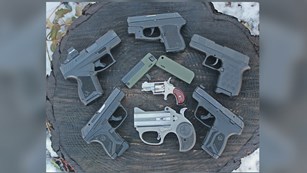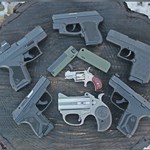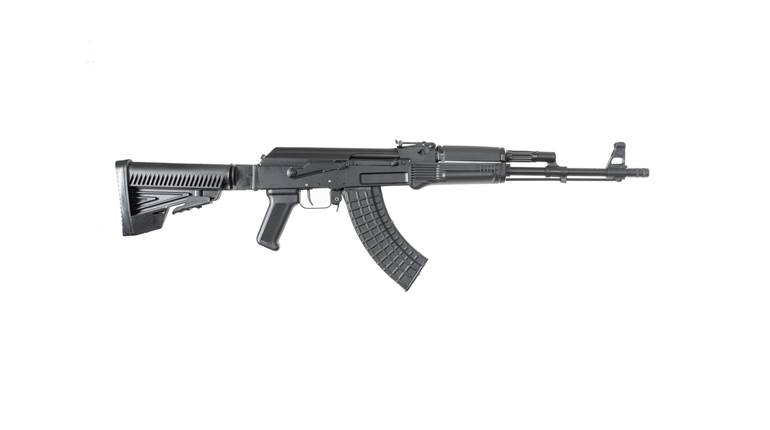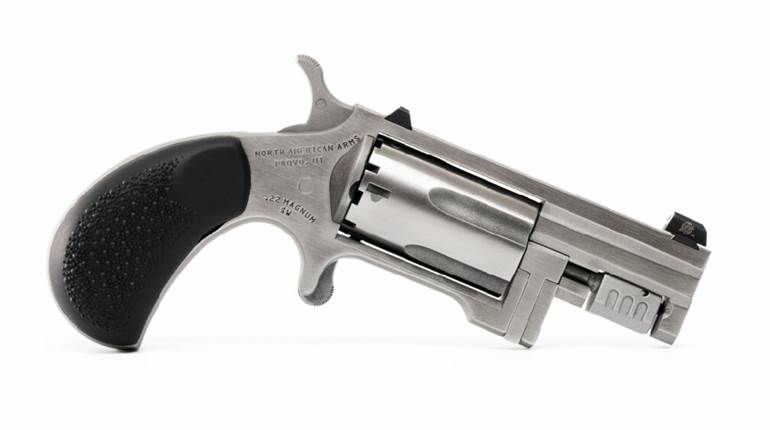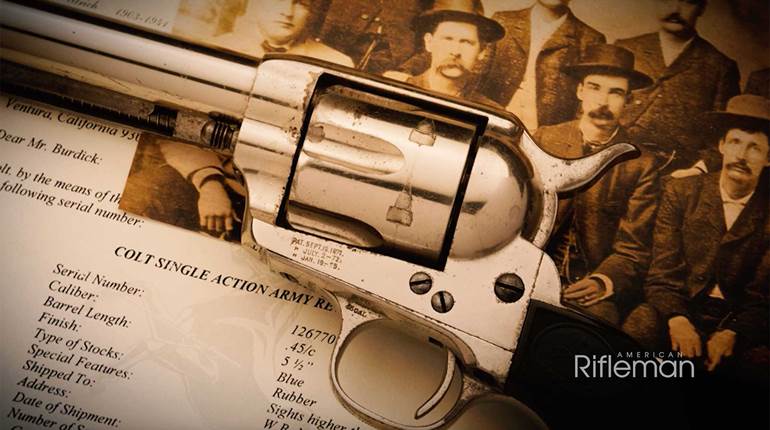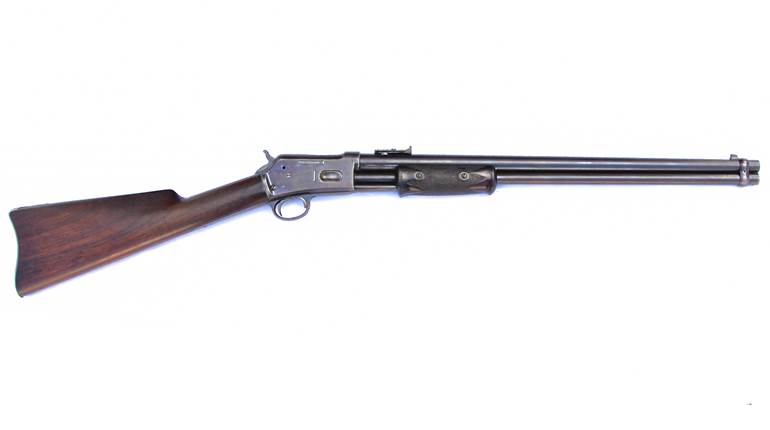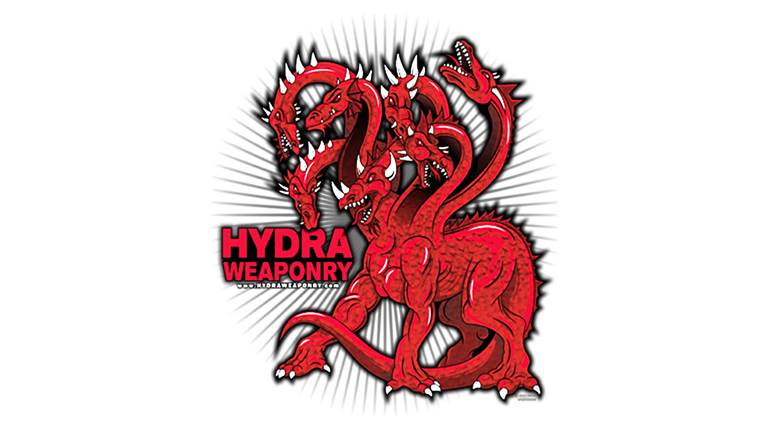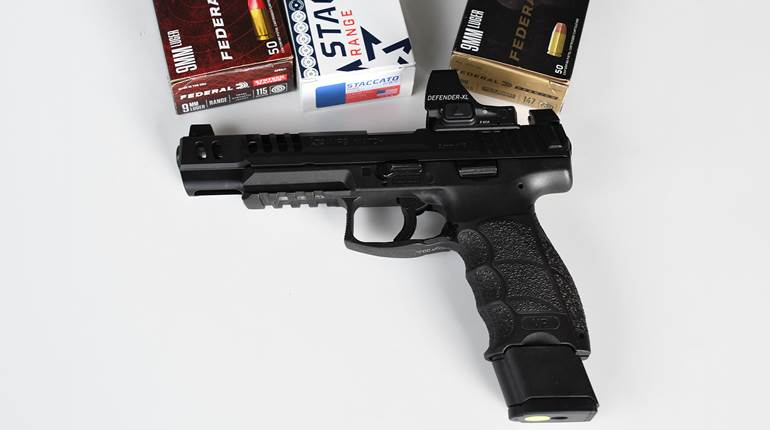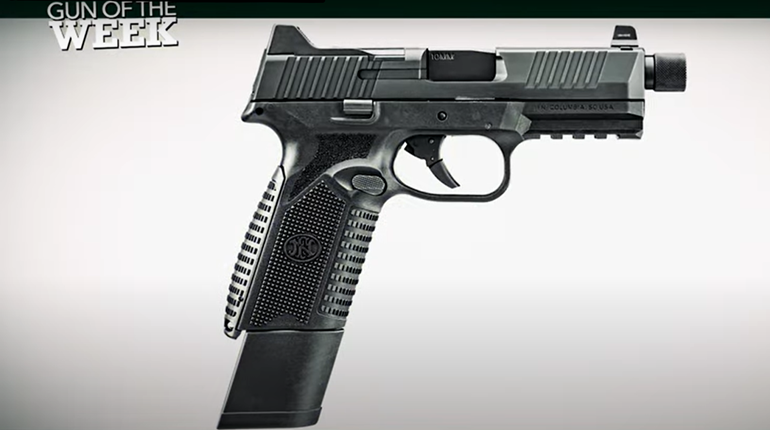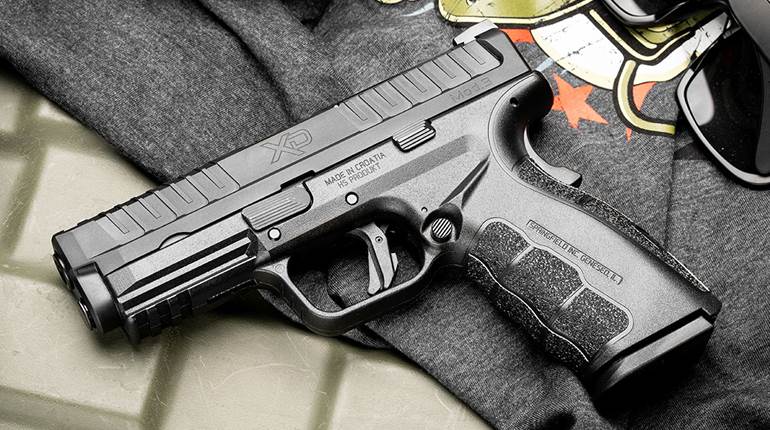
Taurus International has been enjoying robust sales of its multi-caliber revolvers, including the .45 Colt/.410 Judge and the 992 Tracker .22 LR/.22 Mag. with interchangeable cylinders. Working in conjunction with its sister company, Rossi Firearms, the two Brazilian gunmakers have combined these popular Taurus revolver actions with Rossi’s shoulder stocks and rifle-length barrels to produce the Rossi Circuit Judge. This revival of the old revolver carbine provides an unusual twist in that these guns can chamber more than one caliber of ammunition.
Once revolvers arrived on the shooting scene, revolver-action rifles were not far behind.
The first repeating rifle adopted by the U.S. military for combat was the blackpowder Colt 1855. Available in both rifle and carbine configurations, this revolving long gun exhibited two problems that have been resolved in their modern Rossi counterparts. First, the paper cartridges used to load blackpowder into the 1855 could tear and leak into the mechanism of the carbine. This loose powder could ignite when the gun was fired causing all of the chambers of the gun to go off at once. This event, known as a chainfire, caused the gun to blow apart. Modern smokeless powder pistol cartridges and shot shells eliminate this issue.
The second problem with early revolving carbines was the hot gas escaping sideways from the gap between the cylinder and the barrel. This is not much of a concern when firing a revolving handgun because both hands are behind the cylinder gap. Placing a support hand under the barrel of a revolving carbine, as you would with other long guns, resulted in nasty burns to the hand or arm of the shooter. The Rossi Circuit Judge design eliminates this problem with the installation of gas-deflector shields on the frame near the cylinder gap as well as a wedge-shaped flair to the forearm between the cylinder and where the shooter’s hand rests. These enhancements successfully work to protect the shooter.
Circuit Judge Features
Both the .45 Colt/.410 and .22 LR/.22 Mag. configurations share several features in common. The barrels are 18.5-inches long and topped with adjustable fiber-optic sights, and Weaver sight rails are installed to allow the use of optics. The safety features include a transfer-bar safety and a Taurus security key lock located in the hammer. The cylinders swing out to the left side of the gun like most modern double-action revolvers. The external hammer can be cocked for single-action firing or the trigger can be pulled to fire in double-action mode.
These two revolving-action guns differ from each other in interesting ways. The .45-caliber model fires pistol cartridges and .410 shot shells from a single cylinder. The stocks are hardwood with an unusual, but comfortable, pistol grip on the shoulder stock. The barrel is threaded to accept a toothed choke, called a straight-rifled choke by the manufacturer, for use with.410 shells. A smooth-bore thread protector sleeve is included for use when firing .45 Colt cartridges. Think of the straight-rifled choke as a full choke for use only with .410 shells and the thread protector-sleeve as a cylinder bore choke that can be safely used with .45 Colt or .410 loads, and all will go well.
The .22-caliber Circuit Judge tested for this review is called the Tuffy model because of its lightweight, weather-resistant synthetic stock. The shoulder stock contains a small removable panel in the butt pad that reveals a storage compartment for nine-rounds of spare ammunition. Either .22 Long Rifle or .22 Mag. can be stored in this space and a clear plastic window on the left side of the stock shows how many rounds are present.
This .22 rifle uses interchangeable cylinders to alternate between .22 Long Rifle and .22 Mag. cartridges. The synthetic forearm contains a release lever that allows it to slide forward on the barrel. With the forearm in the forward position, the cylinder is opened and a button on the right of the frame is pressed and held, allowing the cylinder and yoke to be removed from the frame. No tools are required. Just reverse the process to install the alternate cylinder and the gun is ready to fire.
Informal Shooting & Function Testing
The informal testing for the Circuit Judge combo guns produced a lot of noise, gun smoke and perforated targets. This particular gun set called for a good deal more shooting than the average review. Having two guns to work with automatically doubles the round count. But one gun can fire four varieties of .22 Rimfire ammunition, including .22 Short, .22 Long, .22 Long Rifle, and .22 Mag. The other one fires .45 Colt loads as well as 2 1/2- and 3-inch .410 shells of the birdshot, buckshot and slug variety.
The guns proved to be light and handy while firing standing shots. The fiber-optic sights were bright and easy to see. The triggers of both samples used in this review were smooth in double-action mode with a crisp, short let off in single-action mode. For those shooters who are familiar with double-action revolvers, firing a long gun with a double-action trigger feels great and it’s not a challenge to shoot accurately. However, it may take some getting used to for those who cut their teeth on bolt-, lever- or semi-automatic rifles. For new shooters, firing the Circuit Judge with the double-action trigger may prove more intuitive than learning to cycle the slide of a pump-action shotgun or the bolt of a bolt-action rifle.
Both guns were fed from all of the varieties of ammunition I had on hand. The .22 Long Rifle cylinder was charged with .22 Shorts, inexpensive bulk-box rounds, .22 shot shells and premium hollow points, and a wide variety of bullet weights and brands were tested via the .22 Mag. cylinder. The .45 Colt/.410 tasted everything from low-recoil .45 Colt Cowboy loads up to potent standard-pressure self-defense and hunting loads. It should be noted that this gun is not rated for +P, +P+ or "Magnum" .45 Colt ammunition. The .410 shells ranged from light target-grade birdshot loads up to the hard hitting 3-inch Winchester PDX1 round that launches 410-grains of mixed defense discs and BB shot pellets. In short, there were no malfunctions, jams, failures to fire or ejection issues. The Rossi Circuit Judge guns proved to be reliable with a wide range of rounds.
Accuracy Results for the .410/.45 Colt Circuit Judge
When it was time to conduct formal testing with .45 Colt loads, I approached the bench with some reservations. While the Judge revolvers can deliver acceptable defensive accuracy with .45 Colt loads at 7 yards, the accuracy is not stellar much past that range. As it turns out, my concerns about the Circuit Judge were unfounded.
Shooting the Circuit Judge from the bench in a Caldwell Shooting Lead Sled Solo, with a Trijicon RM05 9.0 MOA Dual-Illuminated Amber Dot optic mounted on the sight rail, five consecutive five-shot groups were fired into targets set at 25 yards. All three .45 Colt loads produced at least one five-shot group of 1 inch. The best group average of 1.25 inches was produced by Winchester Supreme Elite 225-grain PDX1 bonded hollow points, followed by DoubleTap 255-grain hard-cast lead semi-wadcutters at 1.3 inches and Hornady Critical Defense 185-grain FTX at 1.4 inches.
The .410 slug shells tested in this gun performed poorly. This is not the fault of the shell manufacturers. The rifled slugs are .410-caliber projectiles. The Circuit Judge barrel is designed to safely fire .452 lead bullets or .454-caliber jacketed bullets loaded into .45 Colt pistol cartridges. This difference of .044 inches leaves plenty of room for a .410 slug to wander on its journey down the barrel and to wander off once it hits the atmosphere. If you need a solid projectile to get the job done, stick with the .45 Colt loads for the best results.
The shot patterns produced by 2 1/2- and 3-inch .410 shells were checked from a self-defense distance of 7 yards using 12x18-inch Birchwood Casey Shoot N-C targets. The straight-rifled choke is designed to stop the spin of the shot wad produced by the barrel's rifling and to compress the shot load like a full choke would. With this choke installed, bird shot groups ranged from 7 to 10 inches depending on the shot size fired. Buckshot loads also performed well with groups ranging from 3 to 5 inches.
In order to safely mix .45 Colt loads in with the .410 shot shells in the Circuit Judge’s cylinder, the straight-rifling choke must be removed and replaced with the cylinder-bore thread protector sleeve. With the sleeve installed, bird shot opened up drastically. The 7- to 10-inch groups at 7 yards spread out to cover the entire target surface. However, buckshot loads showed little to no change in their patterns when fired through the sleeve. This is good to know if the Circuit Judge is going to serve as a campsite or home-defense firearm.
Accuracy Results for the .22 LR/.22 Magnum Tuffy
The .22-caliber Circuit Judge was fun to run with the iron sights. At 25 yards, from a standing position, it was easy to ring a 6-inch steel plate swinging target over and over again. For formal testing, the rifle was outfitted with a good all-purpose scope—the Hawke Panorama EV 3-9x40 IR EV attached with Leupold QRW rings. From the bench, five consecutive, 10-shot groups were fired into targets set at 50 yards for each rimfire load tested.
The best single group of 1.75 inches, and the best group average of 1.85 inches, was produced by the Hornady 25-grain NTX .22 Magnum load. Winchester SuperX Lead Free 28-grain tin hollow points produced a 2.7-inch average, followed by Federal Champion 40-grain full metal jacket loads at 2.9-inches. In the .22 Long Rifle testing, all three rounds fired produced a minimum of one 2-inch group. The best group average of 2.15 inches came from Winchester Dynapoint 40-grain copper plated hollow points, followed by CCI Velocitor 40-grain Gold Dot hollow points at 2.5 inches and Winchester Varmint HE 37-grain segmented lead round nose loads at 2.55 inches. It would have been better to see more groups between 1 to 2 inches in size, but it seems the price of having an omnivorous rimfire revolver carbine is the sacrifice of some accuracy.
Final Thoughts
It’s unusual to find long guns capable of chambering multiple calibers because of the challenges involved in making their actions mechanically reliable with a wide variety of ammunition. Although a revolving action in a long gun does have its limitations, reliability isn’t one of them. The Circuit Judge chambered for .45 Colt or .410 shot shells will comfortably fill any role appropriate for a .410 shotgun and it produces solid accuracy with .45 Colt loads for hunting medium-sized game at short ranges. The .22 Long-Rifle/.22 Mag. interchangeable cylinder model is a lightweight, ultra-reliable plinker that can easily digest just about anything you choose to feed it. The Rossi Circuit Judge revolver-action carbines certainly do offer a unique shooting experience.
Manufacturer: Rossi USA; www.rossiusa.com
Model: Circuit Judge
Action: Double-Action Revolver
Caliber: .45 Colt/ .410 2 1/2-inch & 3-Inch Shells; .22LR/ .22 Mag. Convertible Cylinder
Finish: Blued Steel, Stainless Steel Available
Stocks: Wood, Synthetic Available; .22 Tuffy Synthetic with Accessory Rail and Ammunition Storage
Sights: Adjustable Fiber Optic, Weaver Scope Rail
Barrel Length: 18.5”
Overall Length: 35.6”; Length on .22 is 34.4”
Height: 7.6”
Width: 1.93”
Weight: 5.5 lbs.
Capacity: 5 Rounds; .22 holds 9 rounds
Twist: 1:16.5” RH; .22 twist is 1:18.9” RH
Rifle Grooves: 6; .22 groves number 12
Accessories: Straight-Rifled Choke Tube, Cylinder Bore Choke Tube, Choke Wrench, Bore Brush
Suggested Retail Price: $710; $665 for the .22




